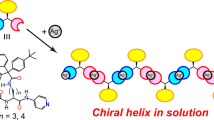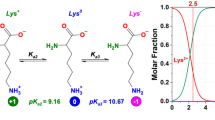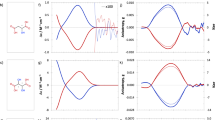Abstract
The chiroptical properties of optically active polyaniline PANI(+)-HCSA emeraldine salt products in dimethylformamide (DMF) depend strongly on stereochemistry and steric crowding due to the presence of different moieties on the amino acids. Amino acids including L-arginine, L-proline, L-leucine, L-isoleucine, L-phenylalanine and L-lysine hydrochloride were used as precursors in emeraldine base/DMF solutions prior to acid doping with (S)-(+)-10-camphorsulfonic acid. Characterization of these materials was carried out using CD, UV-Vis and FTIR spectroscopic techniques. Our results indicate that the optical activity can be maintained for longer times in the solid and solution phases owing to the interactions and stabilization of polyaniline by hydrogen bond formation between the amino-acid molecules and the amine (NH) and imine (−N=) sites on the emeraldine base form, while preserving the stereo-selectivity of the polymer chain. This paper addresses the factors responsible for influencing the chiroptical properties in helical conducting polyaniline and the chiral discrimination of different amino acids.
Similar content being viewed by others
Log in or create a free account to read this content
Gain free access to this article, as well as selected content from this journal and more on nature.com
or
References
Kumar, D. & Sharma, R. C. Advances in conductive polymers. Eur. Polym. J. 34, 1053–1060 (1998).
Peeters, E., Christiaans, M. P. T., Janssen, R. A. J., Schoo, H. F. M., Dekkers, H. P. J. M. & Meijer, E. W. Circularly-polarized electroluminescence from a polymer light-emitting diode. J. Am. Chem. Soc. 119, 9909–9910 (1997).
Pu, L. Novel chiral conjugated macromolecules for potential electrical and optical applications. Macromol. Rapid Commun. 21, 795–809 (2000).
Fiesel, R., Halkyard, C. E., Rampey, M. E., Kloppenburg, L., Studer-Marinz, S. L., Scherf, U. & Bunz, U. H. F. Aggregation and chiroptical behavior of a high molecular weight chirally substituted dialkylpoly(p-phenyleneethynylene). Macromol. Rapid Commun. 20, 107–111 (1999).
Moutet, J. C., Saint-Aman, E., Tan-Van, F., Angibeaud, P. & Utille, J. P. Poly(glucose-pyrrole) modified electrodes: a novel chiral electrode for enantioselective recognition. Adv. Mater. 4, 511–521 (1992).
MacDiarmid, A. G. & Kaner, R. B. in Handbook of Conducting Polymers (ed. Skotheim T.A.) 718 (Skothim Marcel Dekker, Inc, New York, 1986).
Gustafsson, G., Cao, Y., Treacy, G. M., Colaneri, N. & Heeger, A. J. High performance photonic devices made with semiconducting polymers. Nature 357, 477–4779 (1992).
Yashima, E., Maeda, K., Iida, H., Furusho, Y. & Nagai, K. Helical polymers-synthesis, structures and functions. Chem. Rev. 109, 6102–6211 (2009).
Zhang, X. & Song, W. Potential controlled electrochemical assembly of chiral polyaniline with enhanced stereochemical selectivity. Polymer 48, 5473–5479 (2007).
Pornputtkul, Y., Kane-Maguire, L. A. P. & Wallace, G. G. Influence of electrochemical polymerization temperature on the chiroptical properties of (+)-Camphorsulfonic acid-doped polyaniline. Macromolecules 39, 5604–5610 (2006).
Yan, Y., Yu, Z., Huang, Y., Yuan, W. & Wei, Z. Helical polyaniline nanofibers induced by chiral dopants by a polymerization process. Adv. Mater. 19, 3353–3357 (2007).
Yuan, G. L. & Kuramoto, N. Helical polyaniline induced by specific interaction with biomolecules in neutral solution. Polymer 44, 5501–5504 (2003).
Ashraf, S. A., Kane-Maguire, L. A. P., Majidi, M. R., Pyne, S. G. & Wallace, G. G. Influence of the chiral dopant anion on the generation of induced optical activity in polyanilines. Polymer 38, 2627–2631 (1997).
Egan, V., Bernstein, R., Hohmann, L., Tran, T. & Kaner, R. B. Influence of water on the chirality of camphorsulfonic acid-doped polyaniline. Chem. Commun. 37, 801–802 (2001).
Boonchu, C., Kane-Maguire, L. A. P. & Wallace, G. G. The effect of added water on the conformation of optically active polyaniline in organic solvents. Synth. Met. 135–136, 241–242 (2003).
Mire, C. A., Kane-Maguire, L. A. P. & Wallace, G. G. Influence of added hydrogen bonding agents on the chiroptical properties of chiral polyaniline. Synth. Met. 159, 715–717 (2009).
Draman, S. F. S., Daik, R. & Ahmad, M. Synthesis and studies on fluorescence spectroscopy of CSA-doped polyaniline solution in DMF when exposed to oxygen gas. Malay Polym. J. 4, 7–18 (2009).
Kane-Maguire, L. A. P., MacDiarmid, A. G., Norris, I. D., Wallace, G. G. & Zheng, W. Facile preparation of optically active polyanilines via the in situ chemical oxidative polymerisation of aniline. Synth. Met. 106, 171–176 (1999).
Acknowledgements
We are thankful to Professor PB Sharma, Vice-Chancellor, Delhi Technological University (formerly Delhi College of Engineering), Delhi for encouragement and support. We are also thankful to DST, New Delhi for a financial grant under the DST-JSPS collaborative research program. Financial support to one of the authors, Sudha, is also acknowledged.
Author information
Authors and Affiliations
Corresponding author
Additional information
Supplementary Information accompanies the paper on Polymer Journal website
Supplementary information
Rights and permissions
About this article
Cite this article
Sudha, Kumar, D. & Iwamoto, M. Investigation of the chiroptical behavior of optically active polyaniline synthesized from naturally occurring amino acids. Polym J 45, 160–165 (2013). https://doi.org/10.1038/pj.2012.127
Received:
Revised:
Accepted:
Published:
Issue date:
DOI: https://doi.org/10.1038/pj.2012.127
Keywords
This article is cited by
-
Chiral polyanilines: synthesis, chirality influencing parameters and applications
Polymer Bulletin (2024)
-
Arginine-polyaniline@g-C3N4 for outstanding retention of Orange G dye from water
Carbon Letters (2023)
-
Synthesis and fluorescence sensing of energetic materials using benzenesulfonic acid-doped polyaniline
Journal of Materials Science: Materials in Electronics (2022)
-
Optically active polyurethane based on tyrosine: synthesis, characterization and study of hydrogen bonding
Polymer Journal (2016)



